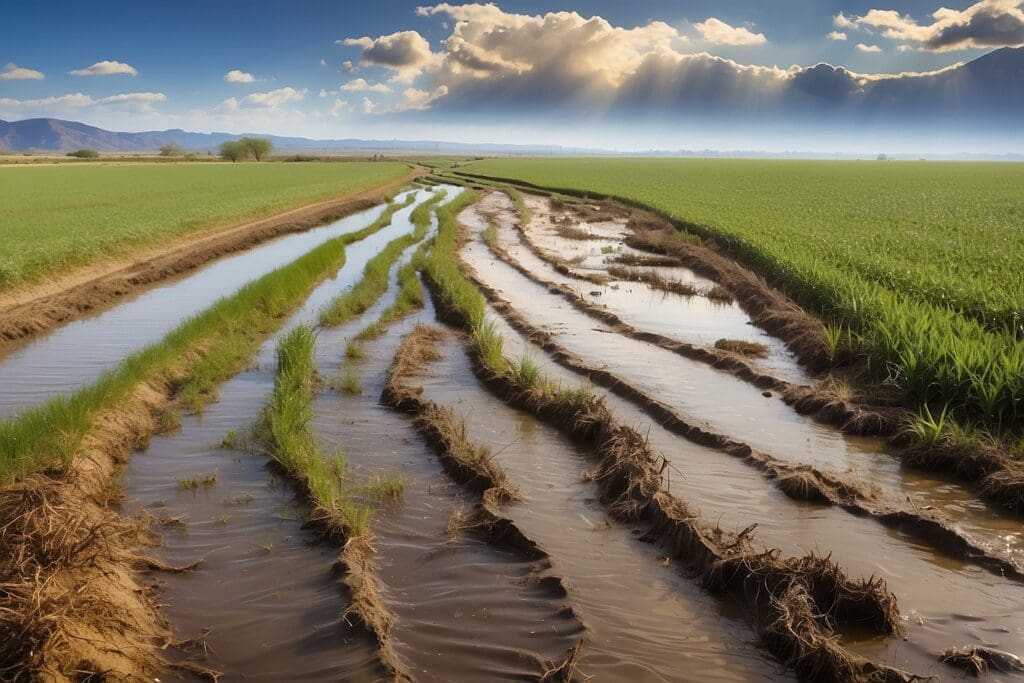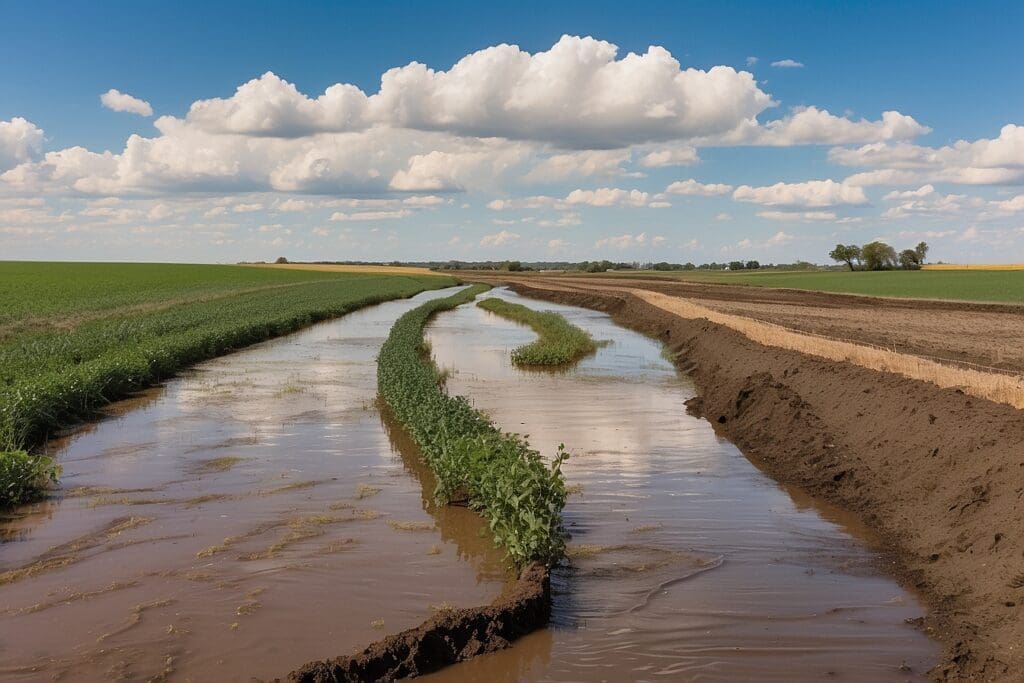Agricultural runoff is a broad term for agricultural byproducts that are not absorbed by fields or soil mass, but rather find themselves running loose into bodies of water such as lakes and rivers.1 Runoff can include agents such as effects of water pollution continue to be felt in both the developed and developing world. While it was a long time ago that the grim 20th century realities of early industrialization were illustrated in Upton Sinclar’s The Jungle, it is imperative that the environmental community is cognizant of a new generation of water quality related issues specifically stemming from highly mechanized agriculture.
Sources of Runoff
https://greeniacs.10web.site/GreeniacsArticles/Water/Water-Pollution.html”>water pollution .
The concept of overloading in agricultural runoff is best conceptualized with the analogy of a sponge. Eventually, any dishwashing sponge becomes saturated with water resulting in the overflow of water from the sponge. In one scenario, soils may become saturated with agricultural waste and moderate rainfall can easily carry this agricultural waste into water bodies. The ability of soils to absorb runoff, however, is also influenced by human activity. Over-grazing land, urban development, mining, and cover crops are highly recommended for open land areas devoid of vegetation.
Impacts of Runoff
- Eutrophication
fertilizers . Nearly 8000 years ago,8 the first manure based fertilizer was utilized, and the modern age has ushered in a revolution in fertilizer use with the availability of mass manufactured synthetic pesticides.9 While fertilizers continue to sustain our basic needs and requirements on a daily basis, they are unfortunately a leading agent for the devastating effects of agricultural runoff that continues to place our water supply and natural marine environment in danger.
Fertilizers are powerful supplements for plant growth due to three main elements: nitrogen, phosphorus, and potassium.10 Unfortunately, this carefully crafted cocktail of sustenance for plants fertilizes organisms other than plants once they find their way into various water bodies, specifically lakes. depletes the ocean water of solubilized oxygen critical for all marine fish and mammals, but can also prevent sunlight from reaching phytoplankton and photosynthesizing marine plants. As a result, some of the most basic effects of a red tide are large scale fish die outs that result in the washing ashore of thousands of dead fish in affected areas. Red tides can become even more devastating with the red algae in question produces neurological toxins, such as saxitoxin from the Alexandriumm species. Paralytic and diarrhetic shellfish poisoning 14 can kill or severely impair individuals who have consumed marine organisms exposed to these toxins. The bioaccumulation of these heat resistant toxins up the food chain poses as a severe health risk, and often leads to the shutdown of many profitable fisheries across the country.15
- Turbification
Turbidity is a measure of the clarity of a fluid based on optical scattering measurements.16 In other words, highly turbid water is extremely cloudy and one would be unable to see through it. Eutrophication increases turbidity of water bodies, but specifically at the surface of lakes or rivers. Large depositions of sediment from swathes of soil that have runoff from nearby land masses pose an additional problem of increasing the turbidity of nearby rivers and lakes. A more uniform deposition of large quantities of soil particles in water bodies can block sunlight to deeper levels of the ocean environment, where photosynthesizing plants are prevented from creating oxygen for marine life.17 Additionally, mucky soil particles can clog fish gills and choke fish larvae, which in turn alter the marine ecosystem.
- Pesticide Contamination

The use of herbicides, insecticides and fungicides save approximately 40% of crop yields in the United States and have allowed for economies of scale in agriculture.18 Modern agricultural practices, however, have resulted in rampant usage of pesticides beyond sustainability. Agricultural runoff containing pesticides can potentially have devastating effects on fish and may bioaccumalate in bigger fish that are consumed by human populations. Another big concern regarding pesticide is their ability to inadvertently contaminate groundwater supplies for human consumption. Half of the American population still obtains drinking water from groundwater sources,19 and a major concern is the ability of some pesticides to accumulate in fatty tissue and their ability to effect pregnant women and women while they breastfeed infants. Additionally, the task of detecting and decontaminating pesticides from groundwater is an expensive, cumbersome, and very gradual process. Therefore, once a groundwater source is contaminated it is no easy task to purify the contaminants out of the source.
 iii
iii
- Biological Contamination
One of the key components of agriculture runoff is manure from feedlots when not properly disposed. While the prospects of manure contaminating water bodies may sound disgusting, the prospect of manure contaminating groundwater sources is even more worrisome. If we take the example of the cow, the manure material from cows are loaded with often deadly bacteria that may not affect the cow but cause debilitating disease in human beings. One of the most prominent examples is Escheria coli 0157 :H7, which is found in 30% of feedlot cattle.20 The bacterium is shed in the fecal matter of cattle, and is capable of causing debilitating cramping and diarrhea in infected humans.21 The feedlot system of animal husbandry routinely causes E.coli outbreaks in the United States, and agricultural runoff would exacerbate the effects of outbreaks that could occur if animal waste finds itself drawn into a groundwater supply. E.coli itself is a fairly rugged organism, with variants of the bacterium occupying numerous ecological niches and capable of surviving in many environments for extended periods of time.
Runoff Prevention
Agricultural runoff poses as a major public health and environmental hazard for our waterways. The most effective weapon against the issue comes in the form of preventative measures that mitigate waste and maximize sustainable agricultural practices. As the natural runoff sponge of our ecosystem, soils must be maintained at optimal levels to maximize their protective abilities. Once soil is eroded , it is impossible to regenerate as it typically takes thousands of years to form.22
A very simple mechanism of maintaining agricultural soil would be to encourage the practice of crop rotation. Crop rotation simply involves the planting of different varieties of plants seasonally to preserve the nutritional content of soils during the growing seasons.23 Crops such as corn and tomato tend to deplete the nitrogen and phosphorus content of soils very rapidly, and as a result unbalanced soil may not longer be able to sustain plant growth which in turn enables greater water retention and reduces runoff.
Another agricultural practice that improves soil health is called conservation tillage, in which the soil is not disturbed by tilling as frequently as in commercial agriculture.24 Amazingly, the lack of tilling reduces the tendency for soils to erode and therefore the strategy is a fairly easy way to minimize erosion provided the farmer follows the appropriate guidelines for no-till agriculture. Similarly, the method of contour plowing, or plowing in curves along slopes, helps channel rainwater away from productive fields that are carrying precious soil. Contour plowing in combination with the planting of cover crops can dramatically reduce soil erosion.
To minimize excessive fertilizer use, farmers should make use of Best Management Practices for Agricultural Nutrients,25 a series of guidelines to optimize soil nutritional content. Some of these guidelines include routine soil tests for nutrient composition, the management of yield goals for individual fields, the selection of appropriate nitrogen sources based on climate and topography, and water management practices to separate manure from drainage outlets. Similarly, pesticide use can be minimized by following a type of strategy known as Integrated Pest Management (IPM).26 Some approaches in IPM include using pest resistant varieties of crop, selection of low toxicity pesticides and the creation of habitats for pest predators that may be beneficial against crop pests.
Most importantly, however, is the need for greater political and cultural changes against unsustainable agricultural practices that are increasingly polluting water bodies around the U.S. and the world. As a non-point source of pollution, the solution needs to promote widespread outreach and education while incentivizing agricultural practices that shun wasteful practices. While examples such as the Farm Bill of 2002 are great moments in our history that have emphasized the need for conservation in agriculture,27 a greater push is needed to underscore agricultural runoff as an indicator of the widespread systemic issue of land management that affects us in nearly every facet of modern living.





